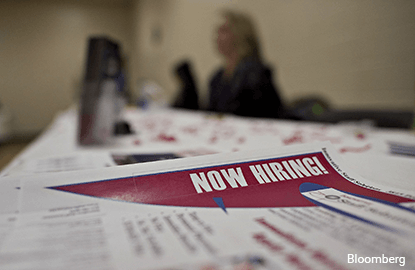
WASHINGTON (Feb 4): The number of Americans filing for unemployment benefits rose more than expected last week, suggesting some loss of momentum in the labor market amid a sharp economic slowdown and stock market selloff.
Signs of creeping employment weakness were also flagged by another report on Thursday showing a 218% jump in announced job cuts by U.S.-based employers in January. The planned layoffs were concentrated in the energy and retail sectors.
"The future is somewhat darker ... the labor market may be past its peak for this cycle. It looks like the labor market has scaled back its rapid advance last month," said Chris Rupkey, chief economist at MUFG Union Bank in New York.
Initial claims for state unemployment benefits increased 8,000 to a seasonally adjusted 285,000 for the week ended Jan 30, the Labor Department said.
Still, claims remained below 300,000, a level associated with strong labor market conditions, for the 48th straight week. That is the longest run since the early 1970s.
The four-week moving average of claims, considered a better measure of labor market trends as it irons out week-to-week volatility, rose 2,000 to 284,750 last week. Economists had forecast claims rising to 280,000 in the latest week.
The rise in layoffs came amid a slowdown in economic growth. The economy grew at only a 0.7% annual pace in the fourth quarter, held back by the headwinds of a strong dollar and faltering global demand.
A downturn in capital spending by energy companies, reeling from a collapse in oil prices, and inventory destocking by businesses are also constraining growth. At the same time, a stock market rout sparked by fears of a global economic slump has caused financial market conditions to tighten.
In a separate report, global outplacement consultancy Challenger, Gray & Christmas said employers reported 75,114 planned job cuts last month, up from December's 15-year low of 23,622. Last month's planned layoffs were the largest since July.
Retailers announced plans to eliminate 22,246 jobs from their payrolls, the most since January 2009. The retail cuts were dominated by Walmart, which announced plans to close 269 stores worldwide. The downtrodden energy sector announced plans to reduce its headcount by 20,246, up from 1,682 in December.
"It remains unclear how much of the deterioration in the data is related to an unfavorable shift in the weather and an increase in layoffs of temporary workers following the holiday season," said Daniel Silver, an economist at JPMorgan in New York.
In a third report, the Commerce Department reported that new orders for manufactured goods fell 2.9% in December, the largest drop in a year, after falling 0.7% in November.
The reports came on the heels of weak data on export growth and consumer spending that suggest the Federal Reserve will probably not raise interest rates in March. The U.S. central bank raised its short-term interest rate in December for the first time in nearly a decade.
U.S. stock indexes rose, while prices for Treasuries were mixed. The dollar fell against a basket of currencies, touching a 15-week low against the euro and a two-week low against the yen.
Productivity weak
While the claims data has no bearing on January's employment report, which is scheduled to be released on Friday, as it falls outside the survey period, it fits in with perceptions of a deceleration in the pace of job growth.
According to a Reuters survey of economists, nonfarm payrolls are expected to have increased 190,000 last month, after surging by 292,000 in December. The unemployment rate is forecast holding steady at a 7-1/2-year low of 5%.
In another report on Thursday, the Labor Department said nonfarm productivity, which measures hourly output per worker, declined at a 3.0% rate, the biggest drop since the first quarter of 2014, after rising at a 2.1% rate in the third quarter.
The weak productivity data reflected the sharp slowdown in GDP growth during the quarter and an acceleration in the pace of hiring. Nonfarm payrolls rose by an average 284,000 jobs per month.
Productivity grew 0.6% in 2015, the smallest increase since 2013, and has increased at an annual rate of less than 1.0% in each of the last five years. Economists blame softer productivity on a lack of investment, which they say has led to an unprecedented decline in capital intensity.
In the fourth quarter, unit labor costs, the price of labor per single unit of output, advanced at a 4.5% pace, the fastest rate in a year. They rose 2.4% in 2015, the largest gain since 2007.